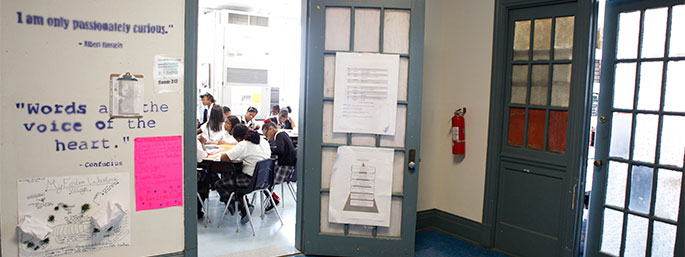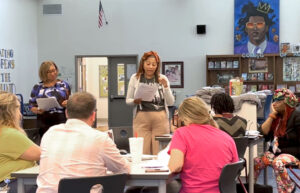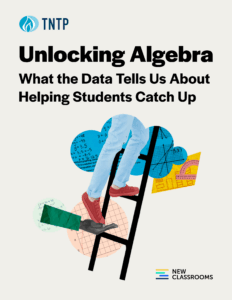When I first started teaching history as a New York City Teaching Fellow more than ten years ago, I walked in ready to give my high school students the same kind of education I had received at an elite private school in the Boston suburbs, rooted in reading, talking and writing about history.
But the dominant set of beliefs about education at the time was that students had different “learning styles,” and we needed to create lessons that would address those learning styles in order for students to learn. Urban students needed “hands-on” learning—which often meant gimmicks like letting them have a shot at the class basketball hoop if they got a question right. A classroom built around complicated, intellectually rigorous discussion was definitely out.
Maybe this seemed like a realistic approach, given the low academic skills many of my students brought to high school—but to me, it felt like a sham. What about life after high school for these students? Would college classrooms have basketball hoops? Would the jobs they’d eventually take allow them to operate in their preferred learning style? High school isn’t an end unto itself; if it doesn’t prepare students for what lies ahead, then the job remains undone.
When the Common Core State Standards emerged, it was both a shock and a revelation—for the first time, the dominant model said that my students, who live in low-income neighborhoods and are predominately Hispanic or African American, would have some guarantee of the same kinds of educational experiences that students at high-performing schools across the country have. All students would be asked to do the hard stuff—and reap the benefits of those high expectations.
To me, this is a fundamentally American value. So I’ve been equally surprised by the backlash against Common Core.
Let me explain exactly what the Common Core asks of my students. For 11th and 12th grade history classes, there are a total of ten reading standards, grouped into four categories. Those standards require students to read challenging texts, integrate knowledge and ideas from multiple sources, identify key pieces of evidence and examine how words are used in context (in other words, the exact mental practices being employed by anyone reading this blog post). They also ask that my students write persuasive analytical essays, as well as informational pieces, and to learn to do research. That’s it.
What does this mean in practice? When my 11th graders studied the civil rights movement last year, we focused our study on why (and if) the movement was successful. My students read materials from the Civil Rights Unit of the Choices Institute at Brown University, primary source documents and selections from I’ve Got the Light of Freedom by sociologist Charles Payne. They watched videos of Stokely Carmichael speeches and studied data on race and equity today. Through it all, they had seminar discussions about major questions raised by the material. At the end of the unit, they wrote essays arguing in what ways they had come to believe the civil rights movement had succeeded, in which they were required to cite evidence to support their arguments. Reading, thinking, expressing and defending ideas—not scary, or prescriptive, or a bunch of meaningless bubble tests.
Criticism of the standards seems to rely on characterizing the Common Core as some kind of conspiracy foisted on the people. Some critics suggest that the Common Core is an “experiment” being conducted on children, as if the standards are a federal power grab, deliberately snuck past an unsuspecting public.
The latest criticism of the Common Core has come from the nation’s two largest teachers’ unions. Both Randi Weingarten of the American Federation of Teachers and Dennis Van Roekel of the National Education Association have decried the “botched implementation” of the new standards. I agree that teachers need more support in making the transition to the Common Core; as an instructional coach in the Boston Public Schools this year, much of my work has focused on helping teachers implement the Common Core, and it’s challenging—but that’s no reason to pull back on implementation.
Finally, there’s this: the complaint that Common Core is just too hard. We can’t expect students to be able to do this level of work in classrooms across the country—and asking low-income students to do so is seen as actually stacking the deck against them. This argument is fundamentally classist. It’s the same old soft bigotry: Poor students just can’t handle the work of advanced reading, writing and thinking, so we shouldn’t ask them to try. Never mind what that means for their lives.
I would ask, seriously and respectfully, what the critics of the Common Core think students should be doing in my high school history classes, besides grappling with challenging reading and articulating their ideas verbally and in writing? What is it they want their own children to be doing in a high school history classroom? What, exactly, is the alternative to the Common Core?
I agree that the Common Core is hard. It sets high academic standards for all of our students. But that’s no reason to give up on it. Come visit my classroom. It’s taken me a long time to figure out how to do it, but you will see students—largely low-income students of color—reading, talking and writing about history in a way that mirrors the work being done in great schools, public or private, across the country. We cannot back down from the Common Core simply because it’s hard. This is the learning that all our children deserve.
Michelle Morrissey has taught in New York City and Boston and is currently a history content specialist in Boston Public Schools. In the fall, she’ll return to the classroom at Academy of the Pacific Rim Charter School in Boston.







